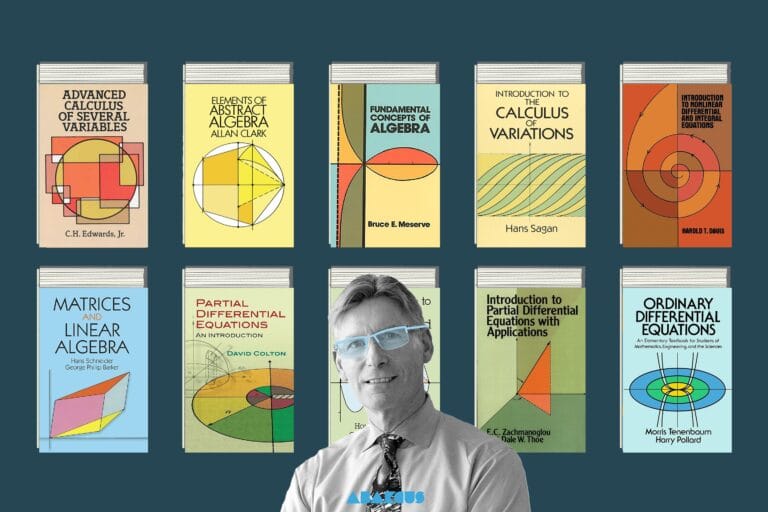Calculus is, at first glance, the great wall standing in the path of anyone who’s into math but feels like they’ve lost the thread somewhere along the way. The moment someone starts talking about “instantaneous change” or mentions “infinitely small parts,” things quickly turn abstract. Formulas are memorized, graphs are drawn—but more often than not, something feels missing: meaning. Because most explanations turn concepts into technical procedures rather than something to be understood.
Yet calculus is, at its core, an attempt to make sense of nature itself. The drift of a falling leaf, the flow of a river, the orbit of a planet across the sky… All of these could be framed as calculus problems. But to make those connections, we need to move from abstraction to something more concrete. Beyond numbers and symbols. Into the motion itself. Into the heart of change.
That’s where visualization steps in. Not just writing the right formulas, but sensing them, feeling them, seeing them—this only becomes possible through the right tools. That moment of blank staring that often happens while learning calculus is really your brain asking for a reference point. And when there’s no visual response to the question “What’s going on here?”, learning stalls.
This article brings together seven tools that complete that missing link. When you ask “What is a derivative?”, they won’t just give you a definition—they’ll show you a movement. When you ask “What is an integral?”, they’ll give you a sense of area. They’ll let you experience approaching infinity, creeping toward zero, feeling change and continuity not just as symbols, but as something real.
Because sometimes, to understand a formula, it’s not enough to look—you have to see.
1. Desmos – A Graphing Platform That Brings Intuition to the Screen

Desmos is not just a simple graphing calculator — it’s a refined platform that makes abstract mathematical ideas come alive on screen. Whether you’re visualizing the slope of a function, the way a tangent line touches a curve, or how an integral accumulates area, Desmos helps transform calculus from symbol to motion.
🌀 A Simple Interface with Deep Power
Desmos greets you with a clean layout: a function entry panel on the left, and a live graphing space on the right. This simplicity is deceptive — Desmos hides immense depth behind its sleek appearance.
For instance: f(x) = sin(x) and f’(x) = derivative(f(x))
With just a couple of lines, you can display both a function and its derivative simultaneously. The derivative graph undulates along with the function itself, almost whispering, “look, the slope increases here… and decreases there.”
📍 Building Intuition with Tangent Lines
Many students memorize that a derivative is the slope of a function, but few truly feel it. Desmos’s tangent line feature is a revelation. A moving point glides across a curve while the corresponding tangent updates in real-time. It’s not just a line — it’s the function’s heartbeat.
You can set up your own parameters, animate the entire domain, and explore how slope behaves across the curve. This isn’t just visualization — it’s exploration.
🔄 Showing Integrals with Dynamic Areas
Desmos can illustrate definite integrals by shading the area under a curve. The real strength lies in how you can manipulate the boundaries dynamically. Attach sliders to a and b, and watch the area shift and change right in front of you.
Integration stops being a mysterious sum of infinitesimals and becomes something you can see growing, evolving.
🧠 Making the Student the Author, Not the Observer
Where many tools lock you into pre-made examples, Desmos puts the chalk in your hand. You build the graphs. You define the behavior. You discover.
This makes Desmos more than a teaching tool — it’s a learning environment.
🎓 A Treasure for Educators
Desmos also empowers teachers with a robust activity builder. They can design custom lessons, assign them to students, and receive real-time feedback — all in a visually engaging format. It’s a staple in many AP Calculus classrooms for good reason: it turns understanding into something inevitable.
In short, Desmos is not merely a graphing tool. It’s a digital window that makes abstract concepts concrete. With Desmos, derivatives become slopes, integrals become areas, and mathematics becomes something you can actually watch unfold.
2. GeoGebra – A Dynamic Space Where Math Becomes Playable

GeoGebra is practically a digital mathematics laboratory. It doesn’t just draw graphs; it performs calculations, generates animations, visualizes algebraic processes, and does it all on an intuitive plane. When it comes to learning calculus, GeoGebra doesn’t just instruct — it invites exploration and discovery.
🧭 Drag-and-Drop Derivatives and Limits
One of the most impressive features of GeoGebra is how it encourages hands-on learning. When you graph a function, you can simply move your cursor over a point to see its slope. A tangent line instantly appears, and the slope value pops up on screen. Just like that, the derivative becomes tangible.
Likewise, limits transform into a visual game of approach. The program dynamically shows left-hand and right-hand limits converging — or failing to converge — as you zoom in. Suddenly, whether a limit exists is something you see, not just something you’re told.
🧮 Riemann Sums and the Birth of the Integral
GeoGebra presents integration not just as an area calculation, but as a process of summation. Watching Riemann sums in action helps students internalize what “adding area” really means. You can adjust the number of rectangles, test different methods like left-endpoint, right-endpoint, midpoint, or trapezoidal rule, and instantly see how the estimate improves.
This interaction doesn’t just explain the how — it helps students understand the why behind integrals.
🧠 Multiple Representations: Graph + Algebra + Numeric
GeoGebra’s real power lies in showing everything at once: a graph, the algebraic formula, and the numerical values. If you’re examining a limit, you can see the graph flatten, track the values in a table, and view the symbolic expression — all side by side. It turns learning into a multi-sensory experience.
🖐 Turning Students into Active Participants
GeoGebra gets students out of the passive role. Every dragged point, every custom function, every changed parameter opens a new window in the learner’s mind. Learning isn’t just something you receive — it’s something you construct.
🧰 Modularity and Community for Educators
GeoGebra’s modular design allows teachers to build their own interactive lessons. And its vast international library means you can find thousands of pre-built resources — from derivatives and integrals to series and multivariable analysis. It’s not just a tool; it’s a global math community.
In short, GeoGebra doesn’t just teach calculus — it invites you to play with it, question it, and understand it from the inside out. If Desmos is a window to watch math unfold, GeoGebra is a lab where you get your hands dirty and make math your own.
3. 3Blue1Brown – A Visual Journey to the Essence of Calculus

If the most effective way to make a math concept intuitive is to set it in motion, then 3Blue1Brown is a master of the craft. The YouTube series The Essence of Calculus, maded by Grant Sanderson, is a masterpiece for anyone trying to understand calculus at a deeper level.
🎥 The Power of Visual Explanation
3Blue1Brown’s videos are not just “beautiful animations” — each one builds an intuitive mental model of the concept it explores. For instance, to explain why the derivative is a limit process, it doesn’t just recite the definition. Instead, it shows a curve evolving over time, with points approaching each other and the slope emerging naturally from that motion. Each frame makes a connection in your mind; every color is a vessel for understanding.
📐 The Meaning of Derivatives and Integrals
The Essence of Calculus series doesn’t just answer “What is a derivative?” It also explores deeper questions: “Why does it matter?” and “What does it represent geometrically?” The slope of a curve stops being an abstract ratio and becomes the pulse of the function. Likewise, integrals are no longer just about computing area — they embody accumulation, continuity, and the balancing force of change.
🧒 Suitable for Beginners, Eye-Opening for Advanced Learners
This series isn’t just for college students — it’s highly accessible to high school learners who are just beginning calculus. As the topics progress, understanding deepens not just through more content, but through clearer intuition. These videos don’t push rote learning; they challenge you to understand.
🌐 Subtitles and Accessibility
Many videos include community-submitted subtitles in multiple languages, including Turkish. This makes the series accessible to a wider global audience. And since it’s hosted on YouTube, it’s completely free and easy to access on any device.
In short, 3Blue1Brown’s Essence of Calculus isn’t a lecture — it’s a visual conversation. It doesn’t tell you what math is. It lets you see it happen. If you want to grasp the heart of calculus, start by watching it unfold.
4. Brilliant – Deepening Insight Through Interaction

Brilliant is not just a platform that delivers information — it’s a space where learning happens through step-by-step discovery. Especially in the context of calculus, its interactive lessons help students understand concepts by reasoning their way through them. It doesn’t offer passive reading — it invites active thinking.
🧱 Building Concepts Step by Step
Brilliant’s calculus modules usually begin with a simple, intuitive question:
“Why does the area under this curve matter?” or “What exactly does a derivative measure?”
From there, the content evolves — each new insight built upon the last, shaped by your responses. It feels more like solving a puzzle than attending a lesson.
🎛 Interactive Demonstrations
Brilliant doesn’t just offer text and graphs. Each course includes draggable graphs, dynamic visuals, instant-feedback multiple choice questions, and annotated solutions. You can modify the bounds of an integral with sliders or explore how limits behave in real time. It’s a lesson you don’t just read — you interact with it.
🧩 Gamified Learning
As the lessons advance, Brilliant presents small challenges — “Can you figure this out too?” These micro-challenges spark motivation and lead to moments of personal insight. Learning becomes more than just cognitive — it’s emotionally satisfying.
🧠 Designed for Every Level
Whether you’re a beginner learning calculus for the first time or someone returning after years, Brilliant’s clear visuals, thoughtful explanations, and well-paced progression make it meaningful for learners at all levels.
In summary, Brilliant isn’t a platform that just explains calculus — it makes you feel it, think it, and play with it. If you want to stay mentally engaged and truly understand what’s going on behind the equations, Brilliant is one of the best companions on that journey.
5. PhET Simulations – Calculus Intertwined with Physics

Developed by the University of Colorado, PhET Interactive Simulations is primarily known as a physics teaching tool. However, within this library are simulations that perfectly illustrate core concepts of calculus in a highly intuitive way. Especially when it comes to understanding the relationships between position, velocity, and acceleration, PhET stands out as a powerful ally.
🚶♂️ Derivatives and Integrals Through Motion
The derivative is fundamentally about change — a concept that’s often taught in the abstract. But when that change is brought to life through the motion of an object, it becomes immediately tangible. Simulations like “The Moving Man” display position-time, velocity-time, and acceleration-time graphs simultaneously, turning the theory into a lived experience. As students drag the character left and right, the graphs respond in real time.
🟦 The True Meaning of Area
Nothing illustrates the physical meaning of integration quite like seeing the area under a velocity-time graph represent displacement. PhET doesn’t just visualize this — it lets students manipulate the parameters, run the simulation, and see the results for themselves. Integration ceases to be a symbolic abstraction and becomes the trace left behind by motion.
🖱 Simple, Fun, and Interactive
The user interface is easy and engaging. The simulations run directly in your browser. Students learn through doing — dragging sliders, adjusting values, interpreting graphs. Learning becomes kinetic and memorable.
🔁 A Cross-Disciplinary Approach
PhET teaches math by embedding it within physical intuition. For many students, this makes abstract calculus concepts feel more relevant and concrete. The derivative is no longer just a fraction — it becomes something observable in the world.
In short, PhET Simulations transform calculus from an abstract set of operations into a lived experience. If the path to learning begins with seeing, then PhET is the light that reveals it.
6. Paul’s Online Math Notes – A Quiet Yet Powerful Guide

Paul’s Online Math Notes has been a go-to resource for calculus learners for years thanks to its simplicity and clarity. It’s not flashy, and it doesn’t use animations — but that’s exactly what makes it powerful. Its mission isn’t to dazzle — it’s to explain. And sometimes, that’s the most effective kind of visual learning.
📊 Static but Effective Diagrams
Every topic is supported by well-designed, hand-crafted visuals. When you’re learning about limits, the geometric meaning of the derivative, or the relationship between integrals and area, these diagrams help make things click. They’re not animated, but their precision and clarity cut through the fog.
📚 Balanced Structure: Explanation + Practice
After each section of theory, you’re presented with a series of example problems, followed by complete solutions. This balance between explanation and application is ideal for reinforcing understanding. It’s especially useful when preparing for exams.
🖨 Printer-Friendly and Fully Accessible
The website is deliberately minimal. No ads, no distractions — just well-organized math. Everything is available to download in PDF format, making it ideal for offline study or printing. You can take your notes anywhere, without needing to stay online.
In short, Paul’s Online Math Notes proves that you don’t need interactivity or high-tech visuals to explain calculus well. With clear explanations and thoughtfully crafted diagrams, it remains one of the most dependable free learning resources available.
7. Calculus Made Easy – A Digital Take on a Classic Book

Martin Gardner’s simplified edition of Calculus Made Easy, originally written by Silvanus P. Thompson, is considered a classic introduction for beginners. Now, the full book has been digitized and beautifully presented at calculusmadeeasy.org, making it more accessible than ever.
📖 A Language That Doesn’t Intimidate
This book doesn’t dive into calculus with flashy symbols or dense theory. Instead, it begins with everyday logic and builds slowly, using examples that are easy to follow. It strips away the formalism and says, “Look, this isn’t as scary as it sounds.” That’s a rare tone in math books — and a welcome one for anyone who feels intimidated by the subject.
💻 Page-by-Page Interactive Reading
The website does more than just display scanned pages. In many chapters, you’ll find dynamic visualizations and annotated explanations added to the text. These enhance the learning process without losing the charm of the original voice. It’s a faithful adaptation that brings the material into the digital age.
🌍 Free and Accessible to Everyone
The entire book is available for free — no login, no subscriptions. It works seamlessly across desktop and mobile devices. Whether you’re a high school student just starting out, or someone revisiting calculus after years, this is a relaxed and approachable way to reconnect with the fundamentals.
In summary, Calculus Made Easy on calculusmadeeasy.org brings together the warmth of a classic teaching voice with modern visual enhancements. It’s a perfect resource for anyone who wants to understand calculus — not just perform it.
Other Noteworthy Tools
In addition to the visual tools we’ve explored in depth, there are several other resources that can make learning calculus more interactive and intuitive. If you’re looking to dive deeper into specific topics or want to experiment with new perspectives, these are excellent additions to your toolkit:
🔺 CalcPlot3D
This tool is ideal for multivariable calculus. It offers 3D visualization of surfaces, gradients, tangent planes, directional derivatives, and more. You can rotate plots, slice through volumes, and observe how functions behave across space — an invaluable resource for anyone tackling partial derivatives or surface integrals.
🔍 Symbolab Calculator
Symbolab breaks down calculus problems step by step, offering both symbolic explanations and graphs. Whether you’re working on limits, derivatives, or integrals, it shows you not only the final answer but also how to get there. A helpful tool for students looking to verify their solutions or study independently.
📘 Ximera Calculus (Ohio State University)
Ximera offers a full online calculus curriculum with structured modules, interactive graphs, embedded problems, and real-time feedback. It’s well-suited for self-paced learners or classrooms, and it’s backed by rigorous university-level content. If you’re looking for a comprehensive and interactive way to study calculus, Ximera is a solid choice.
Whether you’re a visual learner, an interactive explorer, or just someone trying to survive their first calculus class, these additional tools can help broaden your understanding and make the journey far more engaging.







